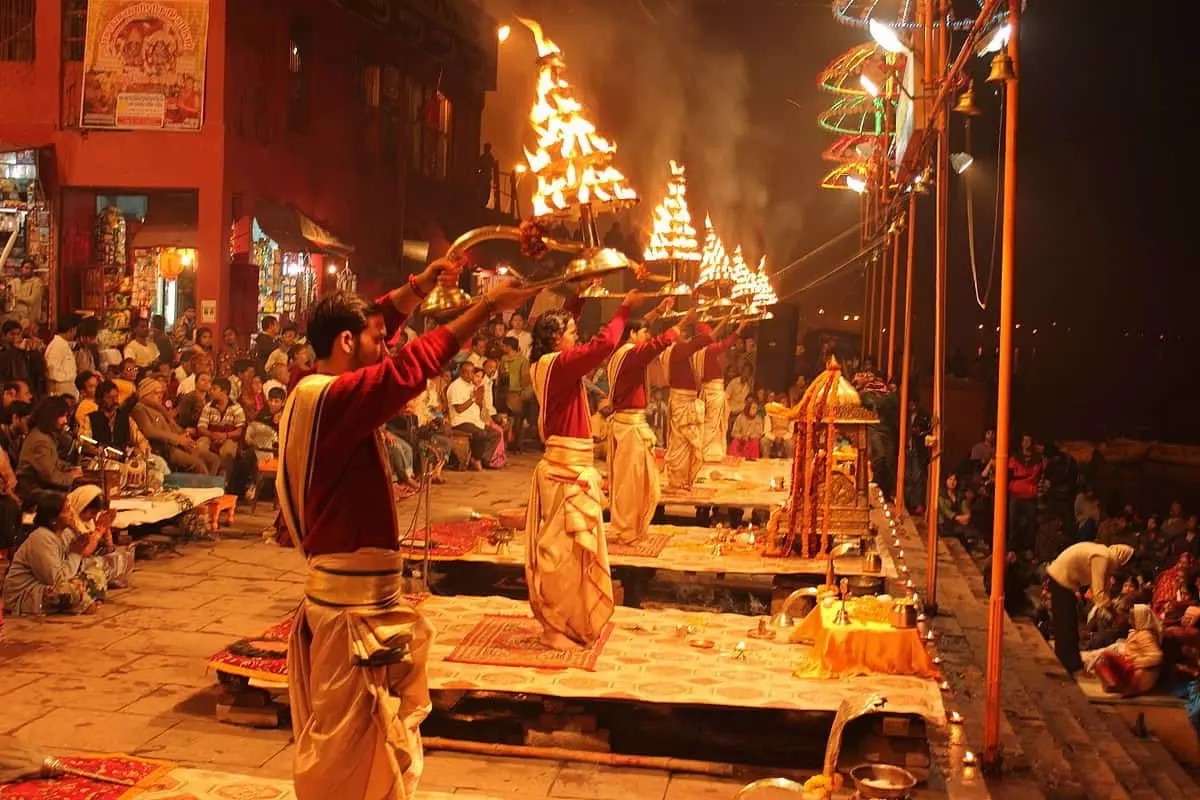Mysteries Of The Varanasi Ganges Aarti

Have you ever wondered about the magic behind the Varanasi Ganges Aarti? This ancient ritual, performed on the banks of the sacred river, draws visitors from around the world. As the sun sets, priests dressed in traditional attire light lamps and chant prayers, creating a mesmerizing atmosphere. The combination of fire, water, and devotion makes this ceremony unforgettable. Whether you're a spiritual seeker or a curious traveler, witnessing the Ganges Aarti offers a unique glimpse into India's rich cultural heritage. Ready to learn more about this enchanting tradition? Let's dive into the heart of Varanasi and uncover the secrets of the Ganges Aarti.
Mysteries of the Varanasi Ganges Aarti
Varanasi, one of the oldest cities in the world, holds a special place in the hearts of many. The Ganges Aarti, a mesmerizing ritual performed on the banks of the sacred river, draws countless visitors. Let's uncover some of the most intriguing aspects of this ancient ceremony.
The Significance of the Ganges Aarti
The Ganges Aarti is not just a ritual; it's a spiritual experience. Each evening, priests perform this ceremony to honor the river, believed to be a goddess. The air fills with the scent of incense, the sound of bells, and the sight of flickering lamps.
Dashashwamedh Ghat: This is the main ghat where the grandest Aarti takes place. Thousands gather here to witness the spectacle. The synchronized movements of the priests, the chants, and the lights create an unforgettable atmosphere.
Assi Ghat: A quieter alternative, Assi Ghat offers a more intimate experience. The Aarti here is less crowded, allowing for a closer connection to the ritual. It's perfect for those seeking a peaceful moment.
Tulsi Ghat: Known for its historical significance, Tulsi Ghat is where the poet Tulsidas wrote parts of the Ramcharitmanas. The Aarti here is simple yet profound, reflecting the ghat's literary heritage.
The Rituals and Their Meanings
Each element of the Ganges Aarti has a deep meaning. Understanding these can enhance the experience and provide a greater appreciation for the ceremony.
Lighting of Lamps: The lamps symbolize the removal of darkness and ignorance. As the priests wave them in intricate patterns, they invoke blessings for all present.
Chanting of Mantras: The mantras chanted during the Aarti are ancient hymns dedicated to the river. These chants create a powerful spiritual vibration, believed to purify the mind and soul.
Offering of Flowers: Flowers are offered to the river as a sign of respect and devotion. This act signifies the beauty and impermanence of life.
Best Time to Experience the Aarti
Timing can make a significant difference in your experience of the Ganges Aarti. Knowing when to visit can help you avoid crowds and find the perfect spot.
Evening Aarti: The evening Aarti, around sunset, is the most popular. The setting sun adds to the magical ambiance, making it a favorite for photographers and spiritual seekers alike.
Morning Aarti: Less known but equally beautiful, the morning Aarti takes place at dawn. The calm and serene atmosphere, combined with the rising sun, offers a tranquil start to the day.
Festival Times: During festivals like Diwali and Dev Deepawali, the Aarti becomes even more spectacular. The ghats are decorated with thousands of lamps, creating a breathtaking sight.
Tips for First-Time Visitors
Experiencing the Ganges Aarti for the first time can be overwhelming. Here are some tips to help you make the most of your visit.
Arrive Early: To get a good spot, especially at Dashashwamedh Ghat, arrive at least an hour before the Aarti begins. This ensures you have a clear view of the ceremony.
Respect the Rituals: Remember that the Aarti is a religious ceremony. Dress modestly, avoid loud conversations, and follow the lead of the locals.
Capture the Moment: While it's tempting to take photos, try to balance capturing the moment with being present. Sometimes, the best memories are those experienced without a lens.
Local Legends and Stories
The Ganges Aarti is steeped in legends and stories that add to its mystique. Learning about these tales can deepen your understanding of the ceremony.
The Legend of Lord Shiva: Varanasi is closely associated with Lord Shiva. According to legend, he performed the first Aarti here, blessing the river with his divine presence.
The Tale of the Ten Horses: Dashashwamedh Ghat gets its name from a myth where Lord Brahma sacrificed ten horses to welcome Lord Shiva. This story adds a layer of historical significance to the ghat.
The Eternal Flame: Some believe that the flame used in the Aarti has been burning for centuries, passed down through generations of priests. This eternal flame symbolizes the undying spirit of Varanasi.
Embracing the Spirit of Varanasi
Experiencing the Ganges Aarti in Varanasi is like stepping into a world where time stands still. The vibrant rituals, the chants, and the flickering lamps create an atmosphere that’s both mystical and sacred. This ancient ceremony offers a glimpse into the spiritual heart of India, leaving visitors with a sense of peace and wonder.
Whether you’re a seasoned traveler or a curious newcomer, witnessing the Ganges Aarti is a must. It’s not just a spectacle; it’s a profound experience that touches the soul. As you stand by the river, surrounded by the faithful, you’ll feel a deep connection to something greater than yourself.
So, next time you find yourself in Varanasi, make sure to take part in this unforgettable ritual. It’s an experience that will stay with you long after you’ve left the banks of the Ganges.

